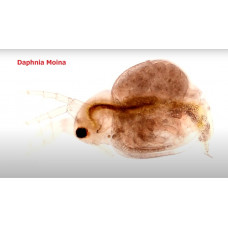A genus of branchiopod crustaceans. Body length 1-3 mm. They have a facet eye, less commonly an additional nauplius eye. The chitinous carapace is transparent, oval in shape; its flaps are joined on the dorsal side and open in the form of a slit on the ventral side. About 60 species. Widespread in freshwaters (often in clumps). Feed by filtering organic debris and microorganisms from the water. Separate sexes; females reproduce parthenogenetically in summer, dwarf males appear at the end of the season. Fertilised dormant eggs overwinter in protective capsules (ephippia). They are a valuable, nutritious food for fish. Daphnia play the role of intermediate hosts for some worms which, as adults, parasitise various vertebrates, including domestic ducks.
Daphnia
Tags: daphnia


